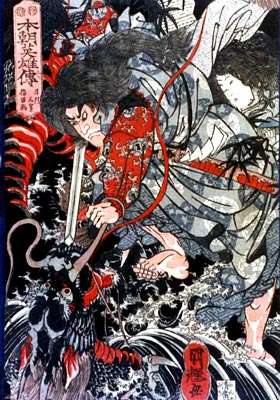Namazu (Japanese mythology)
In Japanese mythology, the Namazu (鯰) or Ōnamazu (大鯰) is a giant catfish who causes earthquakes. He lives in the mud under the islands of Japan, and is guarded by the god Kashima who restrains the catfish with a stone. When Kashima lets his guard fall, Namazu thrashes about, causing violent earthquakes. [1]
History
Following an earthquake near Edo (modern day Tokyo) in 1855 (one of the Ansei great earthquakes), the Namazu became worshiped as a yonaoshi daimyōjin (god of world rectification).[2] Namazu-e (catfish prints) are a minor genre of ukiyo-e.[2] They are usually unsigned and encompass a large variety of scenes such as a namazu forcing the wealthy to excrete coins for the poor, and a namazu atoning for the earthquake he caused.[2]
It is believed by some that the origin of the story is the notion that catfish can sense the small tremors that happen before many earthquakes, and are more active at such times. Supposedly, the sudden activity was observed in ancient times and people believed the quakes to be the result of a giant catfish.
Modern use
Catfish are depicted on pictures of emergency earthquake preparedness activities in Japan. For example, the Earthquake Early Warning (EEW) logo by the Japan Meteorological Agency utilizes pictures of the catfish on devices capable of issuing an early warning. The popular earthquake early warning mobile application Yurekuru Call also has a catfish as their icon.
Namazu is also the name of a song on Danish singer Oh Land's first studio album Fauna which features a large catfish on the album cover.
The Pokémon Whiscash is originally named "Namazun", resembles a catfish and has an earthquake as its signature move. An episode of the Pokémon anime featuring Whiscash was banned when it was scheduled to air too soon after a quake.
The Namazu was featured in the episode of River Monsters, "Cold-Blooded Horror."
Gallery
 Kashima controls a namazu.
Kashima controls a namazu. Namazu the savior.
Namazu the savior. Earthquake Early Warning FM Radio containing an EEW Namazu logo (lower right of top photo)
Earthquake Early Warning FM Radio containing an EEW Namazu logo (lower right of top photo)
References
- ↑ Rabitz, Albrecht & Gisela Rabitz, “When the Namazu Shakes its Body”, Andon, No. 88, 2010, pp. 5-27.
- 1 2 3 Smits, Gregory (Summer 2006). "Shaking up Japan: Edo Society and the 1855 Catfish Picture Prints" (PDF). Journal of Social History. 39 (4): 1045–1078. doi:10.1353/jsh.2006.0057.
External links
- An image of a Namazu from a Tokyo site.
- Namazu-e: Earthquake catfish prints from the period after the Great Ansei Earthquake struck the city of Edo (now Tokyo) in November 1855.

